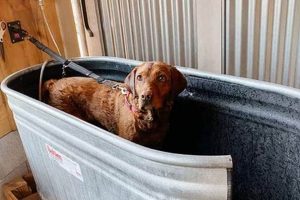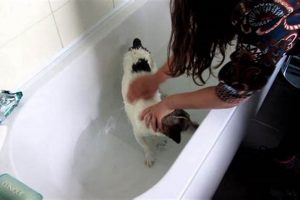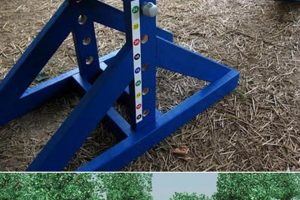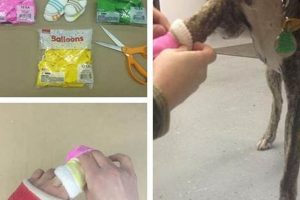Creating a canine disguise shortly before a costumed event involves the construction of an outfit for a dog using readily available materials and minimal time. This often includes repurposed household items or simple alterations to existing pet apparel. For example, a plain dog sweater can become a superhero costume with the addition of a hand-cut felt emblem.
The appeal of quick canine disguises lies in their convenience, affordability, and potential for creative expression. Constructing an outfit oneself allows for personalization and ensures a comfortable fit for the pet, circumventing the challenges of mass-produced costumes. Historically, dressing pets for holidays and special occasions has been practiced for amusement, with contemporary trends favoring simple, homemade options due to time constraints.
Therefore, considerations for pet safety and comfort are paramount when undertaking such projects. Exploring readily available materials, simple construction techniques, and design ideas forms the basis for effective execution. Subsequent sections will address these crucial factors in greater detail.
Essential Considerations for Expedient Canine Costume Creation
The subsequent guidelines are designed to facilitate the rapid and safe construction of costumes for canine companions, emphasizing practicality and the minimization of potential hazards.
Tip 1: Prioritize Pet Comfort: Select lightweight, breathable materials to prevent overheating and discomfort. Ensure the costume does not restrict movement, breathing, or vision. Avoid materials with small, detachable parts that could pose a choking hazard.
Tip 2: Measure Accurately: Obtain precise measurements of the dog’s neck, chest, and back to ensure a proper fit. Ill-fitting costumes can cause irritation or impede movement, increasing the risk of injury.
Tip 3: Utilize Existing Apparel: Repurpose existing dog sweaters, t-shirts, or bandanas as the base for the costume. This minimizes construction time and ensures familiarity and acceptance by the pet.
Tip 4: Employ Non-Toxic Materials: When using adhesives, paints, or dyes, verify they are non-toxic and pet-safe. Opt for water-based options and allow ample drying time before introducing the costume to the dog.
Tip 5: Simplify the Design: Focus on recognizable features rather than elaborate details. Simple shapes and colors can effectively convey the intended character without requiring complex construction.
Tip 6: Secure Fastenings: Use Velcro closures or adjustable straps to ensure a secure but easily removable fit. Avoid zippers or buttons that could pinch or become detached.
Tip 7: Supervise Initial Introduction: Monitor the dog’s reaction to the costume and address any signs of distress or discomfort immediately. A gradual introduction, paired with positive reinforcement, can increase acceptance.
These recommendations emphasize the importance of prioritizing the animal’s well-being during the costume creation process. By focusing on simplicity, safety, and comfort, a suitable and enjoyable outcome can be achieved within a limited timeframe.
The subsequent section will explore specific design ideas and construction techniques that align with these guiding principles.
1. Safety first.
The principle of “Safety first” is paramount when considering the creation of impromptu canine attire. The inherent time constraints associated with this activity can lead to oversights, potentially jeopardizing the well-being of the animal. Therefore, a deliberate focus on safety measures is crucial to mitigate potential risks.
- Material Selection
The choice of materials dictates the overall safety of the costume. Non-toxic, lightweight, and breathable fabrics are preferred. Avoid materials with small, detachable components that could be ingested, leading to choking or intestinal blockage. Furthermore, dyes and adhesives must be explicitly labeled as pet-safe to prevent skin irritation or poisoning.
- Design Considerations
The design itself impacts safety. Costumes should not restrict movement, breathing, or vision. Overly elaborate designs with protruding elements can pose tripping hazards or become entangled in the environment. Simplification is key to both ease of construction and enhanced safety.
- Fastening Mechanisms
The method of securing the costume is a critical safety factor. Avoid sharp or pinching closures such as zippers or buttons. Velcro straps or adjustable ties are preferable, allowing for a secure yet easily removable fit. Regularly inspect the fastening mechanisms for wear and tear to prevent unexpected detachment.
- Supervision and Acclimation
Close supervision is essential during the initial introduction of the costume. Monitor the dog for signs of distress, such as panting, scratching, or attempts to remove the costume. Gradual acclimation, paired with positive reinforcement, can help the animal adjust to the unfamiliar sensation, minimizing anxiety and potential injury.
These interconnected safety considerations are non-negotiable elements in the construction of temporary dog costumes. Prioritizing animal welfare necessitates a proactive approach to risk mitigation, ensuring that the pursuit of festive attire does not compromise the health and safety of the canine participant. The “Safety first” paradigm, therefore, serves as a guiding principle throughout the entire process, from conception to execution.
2. Simple design.
The “Simple design” principle is inextricably linked to the practicality of “last minute diy dog costume” creation. The limited timeframe necessitates designs that are easily executed with minimal resources and technical skill. The absence of intricate details or complex construction techniques directly translates to reduced preparation time, making a functional and aesthetically acceptable outcome achievable under pressure.
The selection of a simple design can be illustrated through various examples. A dog can be transformed into a ghost with a white sheet modified with eye holes, or a superhero cape can be crafted from a repurposed t-shirt. These examples underscore the effectiveness of designs that prioritize recognizability over complexity. The efficiency afforded by these designs is vital, given the time-sensitive nature of such endeavors. Furthermore, simple designs inherently reduce the risk of discomfort or restricted movement for the dog, aligning with the crucial consideration of animal welfare.
In conclusion, the adoption of simple designs is not merely a matter of aesthetic preference but a fundamental prerequisite for successful “last minute diy dog costume” creation. It addresses the limitations of time and resources while simultaneously mitigating potential risks to the animal. Understanding this connection is crucial for anyone undertaking such a project, ensuring both feasibility and ethical considerations are appropriately addressed.
3. Comfort priority.
The emphasis on “Comfort priority” within the context of impromptu canine attire is not merely a matter of owner preference but rather a fundamental ethical and practical consideration. The inherent time limitations associated with constructing a “last minute diy dog costume” often lead to shortcuts that can compromise the animal’s well-being. Disregarding comfort can manifest in several negative outcomes, including skin irritation from rough materials, restricted movement causing anxiety or physical strain, and overheating due to inadequate ventilation. These factors can transform what is intended as a fun activity into a source of stress and discomfort for the dog.
The integration of “Comfort priority” directly impacts the design and material selection processes. For example, using soft, breathable fabrics like fleece or cotton remnants minimizes the risk of chafing. Furthermore, ensuring the costume allows for a full range of motion prevents the dog from feeling constrained or inhibited. Simple modifications, such as leaving ample space around the neck and chest areas, can significantly improve the overall comfort level. The choice of fasteners, such as Velcro instead of elastic bands, is another critical factor; Velcro allows for adjustable fitting, preventing constriction while also facilitating quick removal if the dog exhibits signs of distress. Examples could be easily crafting a loose-fitting cape or altering an existing t-shirt by removing restrictive sleeves.
In summation, “Comfort priority” is not an ancillary component but rather an integral aspect of responsible “last minute diy dog costume” creation. Neglecting this facet introduces unnecessary risks to the animal’s health and happiness. By prioritizing comfort through careful material selection, thoughtful design considerations, and constant monitoring, one can ensure that the activity remains an enjoyable experience for both pet and owner. This understanding underscores the ethical obligations inherent in dressing animals for amusement and emphasizes the importance of informed decision-making, even when time is limited.
4. Household materials.
The utilization of readily available domestic resources is a cornerstone of creating canine costumes within a limited timeframe. The success of such endeavors hinges on the ability to repurpose ordinary items into functional and recognizable attire.
- Fabric Scraps and Old Clothing
Discarded textiles, such as old t-shirts, bedsheets, and towels, serve as primary resources for constructing basic costume components. These materials can be fashioned into capes, vests, or headpieces, requiring minimal cutting and sewing skills. For example, an old pillowcase can be transformed into a simple ghost costume with the addition of eye holes.
- Cardboard Boxes and Packaging Materials
Cardboard provides structural support and enables the creation of three-dimensional costume elements. Boxes can be cut and shaped into hats, armor, or vehicle replicas. Packaging materials like bubble wrap or packing peanuts can be repurposed for padding or decorative accents. An example includes using a cereal box to create a miniature superhero emblem.
- Craft Supplies and Stationery
Common household craft supplies such as felt, construction paper, and glue sticks are essential for adding details and embellishments to costumes. These materials allow for the creation of masks, accessories, and decorative patterns. For example, felt can be used to create animal ears or attach superhero logos to fabric.
- Fasteners and Securing Agents
Securing the costume to the dog requires the use of household fasteners such as Velcro strips, safety pins, and rubber bands. These items provide a means of attaching costume components while ensuring a comfortable and adjustable fit. For instance, Velcro can be used to secure a cape around the dog’s neck without causing discomfort.
The resourceful application of household materials is crucial for achieving effective and expedient canine costumes. The availability of these items within the domestic environment eliminates the need for specialized purchases, thus aligning with the constraints of time and budget typically associated with “last minute diy dog costume” endeavors.
5. Quick assembly.
The feasibility of “last minute diy dog costume” projects is contingent upon rapid construction techniques. The limited timeframe necessitates methods that minimize complexity and maximize efficiency. “Quick assembly” is not merely a desirable attribute but a defining characteristic that determines whether a costume can be realized before the relevant event.
- Simplified Cutting and Shaping
The essence of “quick assembly” lies in minimizing cutting and shaping processes. Straight lines and basic geometric forms are favored over intricate patterns. For instance, a rectangular piece of fabric can be quickly transformed into a cape with minimal alterations, eliminating the need for complex tailoring. This approach conserves time and reduces the skill level required for execution.
- Pre-Existing Item Modification
Modifying existing items, such as dog sweaters or bandanas, significantly accelerates the assembly process. Instead of constructing a costume from scratch, embellishments and additions are made to pre-existing garments. Examples include adding felt shapes to a plain sweater or tying a bandana in a specific manner to create a makeshift headpiece. This approach leverages existing structures to minimize construction time.
- Adhesive-Based Attachment
Adhesives, such as fabric glue or hot glue, offer a rapid alternative to sewing. These adhesives allow for the quick attachment of costume elements, such as felt decorations or cardboard accessories. While sewing provides greater durability, adhesive-based attachment methods are more suitable for projects requiring immediate completion. Selection of pet-safe, non-toxic adhesives is crucial.
- Minimal Seam Construction
When sewing is unavoidable, limiting the number of seams is imperative. Straight seams are preferred over curved or complex ones, and techniques that minimize sewing time, such as using wider seam allowances, are beneficial. Opting for no-sew alternatives whenever possible drastically reduces assembly time.
The aforementioned elements underscore the significance of efficient construction methods in the context of “last minute diy dog costume” initiatives. The ability to rapidly assemble a costume is directly proportional to the likelihood of successful completion within the allotted time. Designs that prioritize simplicity, modification, and adhesive attachment are essential for achieving a functional and aesthetically acceptable outcome under pressure.
6. Accurate sizing.
Proper dimensions are essential for a successful outcome in creating a dog costume under time constraints. Inaccurate measurements directly lead to ill-fitting attire, negating the intended aesthetic effect and potentially causing discomfort or even injury to the animal. Time spent rectifying sizing errors diminishes the already limited timeframe, undermining the purpose of a swift costume solution. An example illustrates this point: a hastily constructed superhero cape, if too long, could pose a tripping hazard, while a neck opening that is too small restricts breathing.
The practical application of precise measurements extends beyond preventing immediate harm. A costume that fits well is more likely to be tolerated by the dog, reducing stress and promoting a positive association with the experience. When constructing a last-minute costume, it becomes even more important to make sure you have the sizing correct to minimize errors. For example, if you’re putting together a quick costume using an existing t-shirt, make sure the arm and neck holes have enough room to keep the dog comfortable all night.
In summary, accurate sizing is not merely a minor detail but a foundational element of safe and effective hurried dog costume creation. Failing to prioritize accurate measurements introduces potential risks and inefficiencies, defeating the purpose of a rapid and resourceful solution. Addressing sizing concerns proactively contributes to both the animal’s well-being and the overall success of the project. Ignoring it can turn a last-minute solution into a long-term problem.
7. Repurposed items.
The integral relationship between repurposed items and rapid canine costume creation stems from the inherent limitations of time and resources. Constructing an outfit from scratch within a compressed timeframe necessitates sourcing materials that are both readily available and easily adaptable. Repurposed items fulfill this requirement by offering a pre-existing structure and form, thereby reducing the need for extensive fabrication. This approach is not merely a matter of convenience but a critical factor in feasibility.
The importance of repurposed items in this context is underscored by numerous practical applications. An old t-shirt, for instance, can be transformed into a superhero cape with minimal cutting and sewing. A cardboard box, readily available from deliveries, can be converted into a miniature vehicle or robot costume with the addition of paint and simple embellishments. Utilizing existing materials, such as scrap fabric, felt, or even discarded household items, mitigates the need for purchasing new supplies, saving both time and money. Examples like these illustrate that effective last-minute solutions often hinge on imaginative utilization of items already present in the home.
In conclusion, repurposed items constitute a cornerstone of feasible hurried dog costume design. Their inherent accessibility and adaptability directly address the challenges posed by time constraints and limited resources. Recognizing and exploiting the potential of existing materials enables the creation of functional and visually appealing costumes without compromising the well-being of the animal. Neglecting this aspect would significantly diminish the likelihood of successful completion within the given timeframe, thereby hindering the objective of a rapid and resourceful solution.
Frequently Asked Questions Regarding Expedient Canine Costume Creation
The following section addresses commonly encountered queries concerning the construction of impromptu dog costumes, offering factual insights and practical guidance.
Question 1: What materials are deemed unsuitable for “last minute diy dog costume” projects?
Materials with small, detachable components present a choking hazard. Fabrics that are not breathable can cause overheating. Dyes and adhesives lacking pet-safe certifications can result in skin irritation or toxicity.
Question 2: How can one ensure a proper fit when time is limited for precise measurements?
Utilizing existing dog apparel as a template offers a reliable basis for sizing. Adjustable closures, such as Velcro straps, provide a degree of flexibility in accommodating minor discrepancies. Prioritize looser fits to avoid constriction.
Question 3: What are the primary safety considerations beyond material selection?
Costume designs should not impede the animal’s movement, breathing, or vision. Secure all attachments to prevent entanglement. Supervise the dog’s initial reaction to the costume and remove it immediately if signs of distress are evident.
Question 4: How can complexity be minimized to expedite the construction process?
Focusing on recognizable features rather than intricate details streamlines the design. Employing simple shapes and colors effectively conveys the intended character. Consider using a dog’s own t-shirt or sweater as the base of the costume, minimizing the time spent on overall construction.
Question 5: What methods are effective for securing costume components without sewing?
Fabric glue or hot glue provides a rapid alternative to sewing, enabling the quick attachment of costume elements. Velcro strips offer a secure and adjustable means of fastening costume components to the animal’s body.
Question 6: How does one address potential discomfort experienced by the dog?
Prioritizing soft, breathable materials minimizes the risk of skin irritation. Ensuring a loose fit prevents constriction and allows for unrestricted movement. Monitoring the dog’s behavior and removing the costume at the first sign of discomfort is crucial.
These responses underscore the importance of balancing expediency with animal welfare when undertaking “last minute diy dog costume” projects. Prioritizing safety, simplicity, and comfort ensures a positive outcome for both pet and owner.
The subsequent section will delve into creative design ideas applicable to time-constrained canine costume creation.
Conclusion
This exploration of “last minute diy dog costume” creation emphasizes the imperative of balancing expediency with animal welfare. Key considerations include prioritizing pet safety, simplifying designs for rapid assembly, utilizing comfortable and readily available household materials, and ensuring accurate sizing to prevent discomfort. These elements are not mutually exclusive but rather interconnected facets of responsible costume construction under limited time constraints.
Adherence to these principles ensures that canine participation in costumed events remains a positive and harmless experience. Prudent execution transforms a potentially stressful undertaking into an opportunity for creative expression and pet owner engagement. Continued adherence to ethical guidelines is paramount in maintaining the well-being of animal companions within the context of celebratory activities.







